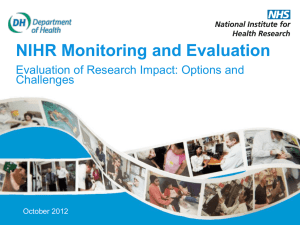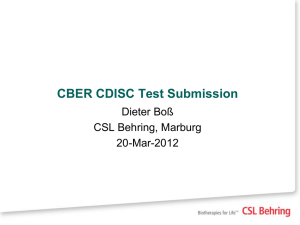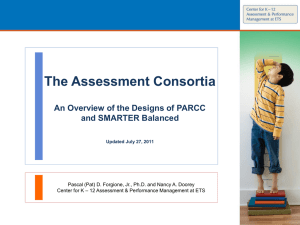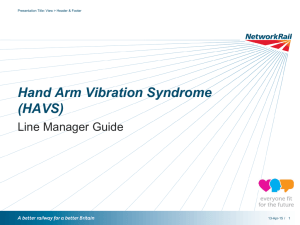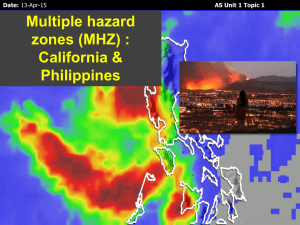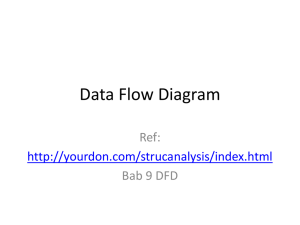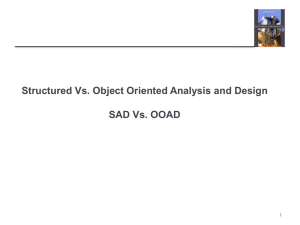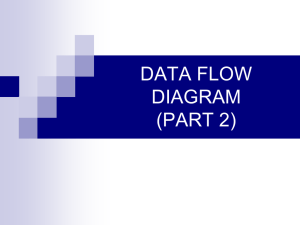Data Flow Diagrams
advertisement
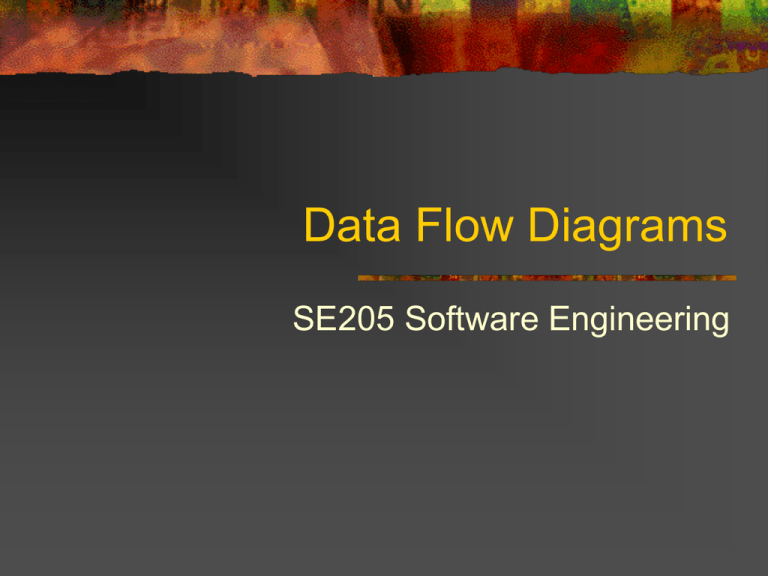
Data Flow Diagrams SE205 Software Engineering Iteration 2: Functional delivery in context 13-Apr-15 Functional delivery Deliver to the client a system that meets most of their needs Usable Stable 13-Apr-15 13-Apr-15 Requirements determination Determine how the current information system operates and what users would like to see in the new system. Outcomes: Various forms of information gathered 13-Apr-15 Structured Modeling We can model the functions of a business using a range of structured diagrams and techniques: Functional decomposition Data flow Entity Relationship Logic structure Structure charts 13-Apr-15 Agile Modeling (AM) AM is a chaordic, practices-based process for modeling and documentation AM is a collection of practices based on several values and proven software engineering principles AM is a light-weight approach for enhancing modeling and documentation efforts for other software processes such as XP and RUP Principles and Practices of Agile Modeling (AM) Other Techniques (e.g. Database refactoring) A Base Software Process (e.g. XP, RUP, DSDM, FDD, …) Your Software Process Copyright 2001-2005 Scott W. Ambler 13-Apr-15 What Are Agile Models? Agile models: Fulfill their purpose Are understandable Are sufficiently accurate Are sufficiently consistent Are sufficiently detailed Provide positive value Are as simple as possible Just Barely Good Enough Ideal Realistic Value Effort Copyright 2005 Scott W. Ambler Agile models are just barely enough! 13-Apr-15 The Core of AM You Need to Adopt at Least the Core Core Principles Core Practices Assume Simplicity Active Stakeholder Participation Embrace Change Apply the Right Artifact(s) Enabling the Next Effort is Your Collective Ownership Secondary Goal Create Several Models in Incremental Change Parallel Model With a Purpose Create Simple Content Multiple Models Depict Models Simply Maximize Stakeholder Display Models Publicly Investment Iterate to Another Artifact Quality Work Model in Small Increments Rapid Feedback Model With Others Software Is Your Primary Goal Prove it With Code Travel Light Single Source Information Use the Simplest Tools 13-Apr-15 Model With Others The modeling equivalent of pair programming You are fundamentally at risk whenever someone works on something by themselves Several heads are better than one 13-Apr-15 Agile Models www.agilemodeling.com/artifacts/ Usage Modeling - Acceptance Tests - Essential Use Cases - Features - System Use Cases - Usage scenario - User Stories - UML Use Case Diagram User Interface Development - Essential User Interface Prototype - User Interface Flow Diagram - User Interface Prototype Supplementary Requirements Modeling Detailed Structural Modeling - External Interface (EI) Specification - Physical Data Model (PDM) - UML Class Diagram - UML Object Diagram - Business Rules - Conceptual Cases - Constraints - Glossary - Technical Requirements Dynamic Object Modeling Conceptual Domain Modeling - UML Communication Diagram - UML Composite Structure Diagram - UML Interaction Overview Diagram - UML Sequence Diagram - UML State Machine Diagram - UML Timing Diagram - Class Responsibility Collaborator (CRC) Cards - Logical Data Model (LDM) - Object Role Model (ORM) Diagram - Robustness Diagram - UML Class Diagram Architectural Modeling - Change Cases - Free Form Diagram - Security Threat Modeling - UML Component Diagram - UML Deployment Diagram - UML Package Diagram Process Modeling - Data Flow Diagram (DFD) - Flow Chart - UML Activity Diagram - Value Stream Map - Workflow diagram 13-Apr-15 Copyright 2003-2005 Scott W. Ambler Agile Documentation Agile documents: Valid reasons to document: Maximize stakeholder investment Are concise Fulfill a purpose Describe information that is less likely to change Describe “good things to know” Have a specific customer and facilitate the work efforts of that customer Are sufficiently accurate, consistent, and detailed Are sufficiently indexed Your project stakeholders require it To define a contract model To support communication with an external group To think something through www.agilemodeling.com/essays/agileDocumentation.htm 13-Apr-15 Data Flow Diagrams 13-Apr-15 Business Process mapping - XSOL 13-Apr-15 Process Modeling Data flow diagramming Graphical depiction of a system Show how data flows through your system and what is being done to it along the way 13-Apr-15 Figure 2-2 A General Depiction of a System 13-Apr-15 Figure 2-4 A Fast Food Restaurant as a System 13-Apr-15 Figure 2-7 A Fast Food Restaurant’s Customer Order Information System Depicted in a Data Flow Diagram 13-Apr-15 Process Modeling Graphically Represents Functions or Processes Which Capture Manipulate Store Distribute data between a system, its environment and its components 13-Apr-15 Deliverables Set of data flow diagrams showing: Scope of system Existing system modeled New system modeled 13-Apr-15 Key Definitions Logical process models describe processes without suggesting how they are conducted Physical models include information about how the processes are implemented 13-Apr-15 Deliverables - ideal 1. Context data flow diagram [DFD] Shows system scope 2. DFD/s of current physical system Specifies people and technologies used 3. DFD/s of current logical system Show data processing functions 4. DFD/s of new logical system 5. Description of each DFD component Data repository 13-Apr-15 Data Flow Diagram Symbols 13-Apr-15 Process The work or actions performed on data so that they are transformed, stored or distributed Verb phrase name, eg, Update Calculate Verify 13-Apr-15 Data store Data at rest, which may take the form of many different physical representations Eg, Database Files Folder 13-Apr-15 Source/sink The origin and/or destination of data, sometimes referred to as external entities Eg, Clients Employees Bank Inland Revenue 13-Apr-15 Data flow Data in motion, moving from one place in the system to another Eg, Invoice Receipt Enrolment form Must be named, often has a paper form associated with it. 13-Apr-15 Concepts Data movement Coupling Timing of data flow DFD hides some Physical Characteristics Frequency Volume of Data 13-Apr-15 Steps in Building DFDs Build the context diagram Create DFD fragments Organize DFD fragments into level 0 Decompose level 0 DFDs as needed Validate DFDs with user 13-Apr-15 Context Diagram Shows the context into which the business process fits Shows the overall business process as just one process Shows all the outside entities that receive information from or contribute information to the system 13-Apr-15 Figure 8-4 Context Diagram of Hoosier Burger’s Food Ordering System • One process only 13-Apr-15 • Single process (0) represents entire system 13-Apr-15 Level 0 Diagram Shows all the processes that comprise the overall system Shows how information moves from and to each process Adds data stores 13-Apr-15 Figure 8-5 Level-0 DFD of Hoosier Burger’s Food Ordering System 13-Apr-15 13-Apr-15 Decomposition of DFDs Functional Decomposition iterative process of breaking down the description of a system into finer and finer detail keep going until point where process can no longer be logically broken down creates a series of exploding charts Level-n diagram 13-Apr-15 Level 1 Diagrams Shows all the processes that comprise a single process on the level 0 diagram Shows how information moves from and to each of these processes Shows in more detail the content of higher level process Level 1 diagrams may not be needed for all level 0 processes 13-Apr-15 Figure 8-7 Level-1 Diagram Showing Decomposition of Process 1.0 from the Level-0 Diagram 13-Apr-15 Figure 8-5 Level-0 DFD of Hoosier Burger’s Food Ordering System 13-Apr-15 Level 2 Diagrams Shows all processes that comprise a single process on the level 1 diagram Shows how information moves from and to each of these processes Level 2 diagrams may not be needed for all level 1 processes Correctly numbering each process helps the user understand where the process fits into the overall system 13-Apr-15 Figure 8-8 Level-1 Diagram Showing the Decomposition of Process 4.0 from the Level-0 Diagram 13-Apr-15 Figure 8-9 Level-2 Diagram Showing the Decomposition of Process 4.3 from the Level-1 Diagram for Process 4.0 13-Apr-15 Your Turn At this point in the process it is easy to lose track of the “big picture”. Sketch a context diagram for your project How many processes? What are the external sources and sinks? 13-Apr-15 Creating Data Flow Diagrams Data flow diagram components Data Store Process Source/Sink Data flow 13-Apr-15 Process The work or actions performed on data so that they are transformed, stored or distributed Verb phrase name, eg, Update Calculate Verify 13-Apr-15 Data store Data at rest, which may take the form of many different physical representations Eg, Database Files Folder 13-Apr-15 Source/sink The origin and/or destination of data, sometimes referred to as external entities Eg, Clients Employees Bank Inland Revenue 13-Apr-15 Data flow Data in motion, moving from one place in the system to another Eg, Invoice Receipt Enrolment form Must be named, often has a paper form associated with it. 13-Apr-15 Concepts Data movement Coupling Timing of data flow DFD hides some Physical Characteristics Frequency Volume of Data 13-Apr-15 Steps in Building DFDs Build the context diagram Create DFD fragments Organize DFD fragments into level 0 Decompose level 0 DFDs as needed Validate DFDs with user 13-Apr-15 Context Diagram Overview of the system showing: System Boundaries External Entities that interact with the system Major information flows between Entities and System 13-Apr-15 Figure 2-2 A General Depiction of a System 13-Apr-15 13-Apr-15 Next step What processes are represented by the single process in the context diagram? • Capturing data from different sources • Maintaining data stores • Producing and distributing data to different sinks • High level descriptions of data transformation operations 13-Apr-15 DFD Layout Tips All process names must be verb phrases Maintain organisation’s viewpoint in naming processes Layouts often place processes in the center inputs from the left outputs to the right stores beneath the processes 13-Apr-15 Level - 0 diagram A dataflow diagram that represents all of the system’s major processes, data flows, and data stores at a high level of detail. Often corresponds to selection of activities on main system menu. 13-Apr-15 Level 0 Tips Generally move from top to bottom, left to right Minimize crossed lines Iterate as needed The DFD is often drawn many times before it is finished, even with very experienced systems analysts 13-Apr-15 Figure 8-5 Level-0 DFD of Hoosier Burger’s Food Ordering System 13-Apr-15 Tips for Level 1 and Below Sources for inputs and outputs listed at higher level List source and destination of data flows to processes and stores within each DFD Depth of DFD depends on overall system complexity Two processes generally don’t need lower level More than seven processes become overly complex and difficult to read 13-Apr-15 Data Flow Splits and Joins A data flow split shows where a flow is broken into its component parts for use in separate processes Data flow splits need not be mutually exclusive nor use all the data from the parent flow As we move to lower levels we become more precise about the data flows A data flow join shows where components are merged to describe a more comprehensive flow 13-Apr-15 Balancing DFD’s Balancing involves ensuring that information presented at one level of a DFD is accurately represented in the next level DFD. 13-Apr-15 Validating the DFD Syntax errors Assure correct DFD structure Semantics errors Assure accuracy of DFD relative to actual/desired business processes User walkthroughs Role-play processes Examine lowest level DFDs Examine names carefully 13-Apr-15 Guidelines for drawing Use a CASE tool: BPWin, Visible Analyst Completeness Consistency no data flows leading to nowhere is nesting appropriate? Timing, never started, never stops Iterative development 13-Apr-15 Summary Requirements Structuring Process modelling Data flow diagrams Deliverables Three sets of DFDs current physical, current logical, new logical 13-Apr-15
